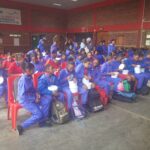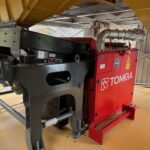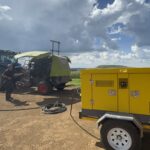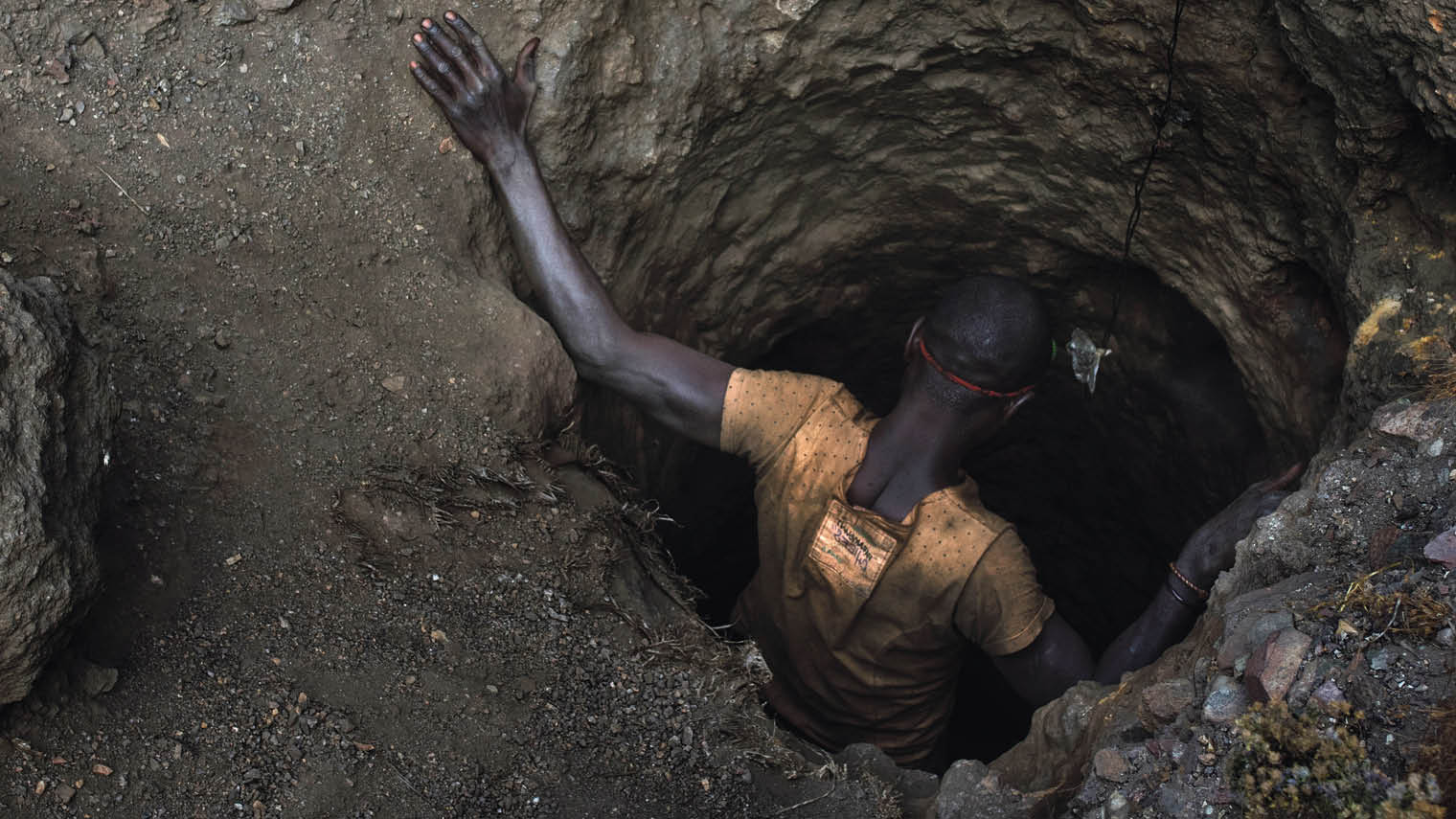In the early 2000s, activists began to campaign against the extraction of “conflict minerals”—a catchall term for gold and the “three Ts” (tin, tantalum, and tungsten) originating from war zones in eastern Congo.
NGO and UN investigations suggested that these “digital minerals,” used in high-end tech products, were driving violent conflict.
The conflict minerals paradigm emerged during an unprecedented rise in the global demand for tantalum around the turn of the millennium, which pushed east Congolese workers and transnational traders to mine for coltan (the mineral from which tantalum is extracted).
While armed conflicts had taken hold of the region in the aftermath of the genocideagainst Tutsi in Rwanda in 1994, violent extraction briefly became the lynchpin of the wars around 2000.
Activist groups painted the DRCongo as home to a brutal resource war and spotlighted the children and women who suffered exploitation, sexual violence, and death in what one former senior UN official called the “rape capital of the world.”
In response to conflict mineral campaigns, governments and international organizations enacted regulations to satisfy consumer demand for gadgets that were produced, supposedly, without sexual violence and war crimes.
In the United States, a draft law against conflict minerals was recycled into the 2010 Wall Street Reform and Consumer Protection Act, better known as Dodd-Frank; its Section 1502 obliged U.S.-listed companies to report conflict minerals in their supply chains, pressuring Congo’s then-President Joseph Kabila to declare a six-month ban on artisanal mining (mining done on a small scale outside the supervision of a mining company).
Congo’s miners—who refer to the legislation as Obama’s law—suffered under the ban on their livelihoods. Still, the European Union followed suit with its own legislation, finally adopted this year. Like the U.S. law, it draws from OECD due diligence guidelines for companies, which have been continuously developed since 2010.
Under pressure from these laws and guidelines, international industry ramped up efforts to create supply chain oversight systems. Alongside regional initiatives such as the International Conference on the Great Lakes Region (ICGLR), the world’s largest tin lobby outfit, ITA (formerly known as ITRI), developed iTSCi, a program to trace shipments “from mines to markets,” which has been operating in eastern Congo since 2012.
The iTSCi program and similar initiatives started from the assumption that mineral demand had caused armed conflict to erupt. But while the minerals played a role, the wars in eastern Congo were rooted in multiple exogenous and endogenous factors: a mixture of geopolitical conditions triggered the late 1990s wars, which merged with preexisting and overlapping conflicts over land and citizenship in what was then eastern Zaire.
Mining was just one way armed groups generated revenue to pursue their goals after the wars had already begun. But major nonprofits focused on the issue to the exclusion of other factors. The Washington-based Enough Project, for example, invested more time lobbying about the trade on U.S. campuses than investigating it in the Congo.
While activist campaigns on conflict minerals have waned, their legacy lives on in ways that adversely affect the lives of Congolese people in mining regions.
Programs for “conflict-free” sourcing were beset by a blind eye to local complexities, single-issue advocacy for Western audiences, and the mismatch between humanitarian justification, consumer-oriented advocacy, and profit-driven reform.
Transnational activists trafficked in imagery of sub-Saharan Africa that reproduced colonial ideas of endemic brutality and the need for rescue. Today, despite the mushrooming landscape of “clean sourcing” projects, violence continues unabated in eastern Congo, underscoring the misguided frameworks governing transnational intervention.
Realities on the Ground
The fight against conflict minerals became a prime example of what Teju Cole has called the “white-savior industrial complex”—efforts that make activists in wealthy countries feel good but fail to consider “the idea that those who are being helped ought to be consulted over the matters that concern them.”
If asked, a petty trader might say she deplores how the war eroded non-mining livelihoods, or how the violent exploitation of minerals helped entrench a climate of impunity.
She might add that her business, and thus the schooling and healthcare of her children, suffers from the unpredictability of illegal taxation and random extortion. She might also express regret that the rise of mining in eastern Congo’s local economies has replaced subsistence with dependence.
How, then, should these problems be addressed? A Western campaigner may suggest sanctions and bans alongside initiatives to address fraud or informality. Congolese activists and miners have their own recommendations and analyses.
Poverty Pricing
In early 2014, we first visited one of the Congolese mines operating under the new, supposedly clean iTSCi scheme, which promised to trace bags of raw minerals from pit to exportation.
The ICGLR, inspired by the OECD guidelines, would certify these exports as conflict-free. The new system, however, which focuses on the Congolese part of the supply chain, does not account for the transnational political economy of minerals, including global pricing.
In countless discussions, Congolese miners told us how they struggled to master the logic of international price fluctuations in major trading hubs such as the London Metal Exchange (LME).
Corporate stakeholders in the new system (Congolese trading houses, middlepersons, smelting companies, and end users such as Apple and Boeing) bank on this asymmetry of information—differentiated access to knowledge, in addition to buyer leverage in a single, closed-circuit, legal supply chain—to impose artificially low prices.
As a result, Congolese mining communities lack the capacity to represent their interests through collective action. An elder we met who had been in the business for decades illustrated the problem for us: while his community had suffered from armed occupation and violence during the 1996–2003 Congo wars, the influx of initiatives to combat conflict minerals and reform the mineral trade led to local prices that were lower than what rebel groups had previously imposed.
Two years later, we carried out a survey in different mines and found that access to education and health had on average decreased between his generation and that of his children.
A recent study confirmed that finding, highlighting that artisanal mining revenues remain largely insufficient to cover basic needs. Physical, armed violence had been replaced by structural violence that even more directly endangered the livelihoods of Congolese mining communities.
Women’s Initiatives
International campaigns framed the correlation of rape, violence, and mining as a causal relationship.
Yet there is growing evidence of domestic violence and abuse in the context of sex work around the mines, with very different dynamics than the portrayal of sexual violence as stemming directly from greedy warlords who drive a violent mineral trade.
This oversimplification was symptomatic of a broader problem. International advocacy against gender-based violence denied the agency of the women in question. In late 2012, we met with representatives of a local women’s association in eastern Congo.
The women we spoke to were unimpressed by high-profile international campaigns featuring Hollywood celebrities, and they bitterly remarked that their own voices and actions were rarely taken into account.
Early in the Congo wars, some of them had organized marches to Kigali and Kampala, the capitals of neighboring Uganda and Rwanda, whose interference was a key factor in the wars of the 1990s.
The aim of the marches was to submit petitions against the abuse of Congolese women by foreign belligerents. At the end of the conversation, one woman asked us why foreigners kept coming to Congo to take pictures while their own initiatives received little to no recognition.
Conservation
In mid-2018, we spoke at length to a Congolese analyst who had dedicated years of research on the debate around Virunga National Park. Created as a colonial institution in 1925, the park is today a flagship for nature conservation, with a particular emphasis on protecting Congo’s mountain gorillas from extinction.
However, adjacent communities face displacement for encroaching on the park’s contested boundaries; some have ancestral land claims, and many are living subsistence lifestyles involving farming, charcoal production, and poaching.
While the park’s heavy-handed militarized approach does generate controversy, its ambitions are also justified every now and then by invoking the conflict minerals paradigm.
Yet there are no relevant mines inside the park; the most prominent rebel groups threatening its integrity as a preserve have either never resorted to mining to finance conflict or never done so inside the park.
When we asked the analyst why conservation advocates still kept the conflict minerals narrative holstered in their campaign arsenals, he asked in return why we would not seek answers outside Congo. It wasn’t local reality but rather foreign advocacy that linked conservation with conflict minerals.
Technical Fixes
International campaigners singled out conflict minerals as the ultimate explanation for war in the Congo and declared transnational regulation to be the prime peacebuilding policy.
The struggle against conflict minerals took the shape of a mission civilisatrice with neoliberal characteristics. The Congolese conflicts were perceived as savage, mindless violence driven by pure greed; the response to this problem was marketization and development.
Transnational regulations of conflict minerals were implemented in places imagined as unruly or empty.
But they were in fact highly organized already—and, unsurprisingly, the imposition of rules in spaces where governance is contested led to backlash and resistance, putting at peril the policy goals of those rules. The efforts to source responsibly were rendered incomplete at best and counterproductive at worst.
The case of iTSCi, the corporate tracing scheme set up by the international tin lobby, is illustrative. The lobby stepped into a field devoid of policy (responsible sourcing) but full of competing, contested orders (local mining governance).
iTSCi attempted to override these problems by hammering out an exclusive deal with the Congolese government, establishing a monopoly over the legal sourcing of tin, tantalum, and tungsten.
On the ground, however, iTSCi was captured by operators rebranding themselves as social entrepreneurs and state bureaucrats who invented new forms of taxation that burdened local producers.
iTSCi ended up “substituting upward for downward accountability”—not entirely unlike the World Bank’s structural adjustment programs decades ago, which punished those with the least decision-making power with the harshest austerity.
The program took the shape of private indirect government, operating with little public oversight; at one point the Congolese government had to request its statistics from iTSCi because it lacked formal access to them.
iTSCi forged a buyer-end monopoly geared at total market control. Mines incorporated into the new traceable supply chain saw buyer-imposed prices, while other mines—no matter whether conflict-affected or not—were de facto excluded from legal trade.
Technical shortcomings also undermined the effectiveness of mineral traceability. Despite its aim to tackle fraud in digital minerals, iTSCi itself is not very digital; it relies on barcoded tags to manually control the itinerary of shipments.
Oversight has been outsourced to sparsely equipped and understaffed teams of its NGO partner Pact and under – or unpaid Congolese civil servants. This backfired: fraud and contamination became commonplace, entangling the dream of conflict-free minerals with the very conflict economies it set out to dismantle.
Congolese miners and small-scale intermediary traders struggled with either monopoly or exclusion. As one local trader told us in 2014, “Selling to iTSCi is like flushing [minerals] down the toilet.”
New Violence
The transnational reforms have failed to stop the violence that led to their creation, despite the scale of the interventions. In some cases, they have created fresh conflicts. Almost ten years after the first timid pilot projects tested iTSCi’s bagging-and-tagging procedure in Mayi Baridi, Kisengo, and Nyabibwe—three small mining areas in eastern Congo—the impact on security is close to nil.
The number of armed groups has risen steadily over the past decade, from thirty to forty when iTSCi kicked in to over a hundred in 2021, as have incidents of violence and human rights violations.
During field research in 2015, we met militiamen guarding mining pits in a remote mountainous area. In interviews, they told us how they had been escorting iTSCi’s recent audit. In another mining area, iTSCi operations have coexisted with regular incidents of homicide and violent dispossession for years.
Moreover, iTSCi’s record of preventing, detecting, and sanctioning fraud, including armed actors in mining as well as in taxing minerals along trade routes, is streaky at best.
In the slipstream of reforms, mining kingpins and middlepersons mastered the art of recycling their reputations. By paying lip service to humanitarian ideals, they were absorbed into “conflict-free” trade.
Even if advocates and policymakers admit in private that resolving conflict in eastern Congo will require more than just rendering the mineral trade more transparent, many public pitches on the topic still allude to solving the conflict minerals issue as the silver bullet for peace in the region.
This is both misleading towards the broader public and factually wrong: many armed groups that coexisted with communities in relative peace resorted to more ambushes and looting as they lost access to minerals.
Unresolved Problems
Ever since Section 1502 of the Dodd-Frank Act was enacted, most U.S. publicly listed companies and their suppliers submitted their conflict minerals reports either late or not at all.
Then in May 2018, President Donald Trump signed a temporary suspension of a number of the act’s provisions, including Section 1502. Trump’s reversal of the regulations was not driven by any concern about the livelihoods of Congolese miners but by the purely commercial interests of American companies.
It was yet another missed opportunity for progressive policy in transnational trade and peacebuilding. As much as Section 1502 itself suffered from an unrealistic assessment of the real dynamics affecting the trade, its dismissal by Trump is unlikely to have positive effects in the Congo.
In January 2019, the Congo saw its first peaceful transfer of power since independence. Following an election widely seen as rigged, Félix Tshisekedi took over from Joseph Kabila.
After a year marked by political infighting in the coalition government between Tshisekedi’s and Kabila’s parliamentary blocs, the new president has since mid-2020 made bold moves to curtail his predecessor’s influence on key institutions such as the Supreme Court, the National Assembly, and the Senate.
Conflict and insecurity in eastern Congo have not been affected by these broader political developments, in part because the political battles at the national level siphoned off nearly all attention by major stakeholders.
Eastern Congo’s artisanal mining sector also continues to suffer from neglect because the country’s political economy remains mostly focused on the much larger copper and cobalt sectors in the south.
After renewed peaks in attacks and forced displacement in eastern Congo in early 2021, the central government declared a state of siege, replacing civilian administrations in two provinces (North Kivu and Ituri) with military governors.
Meanwhile, a third conflict-affected province, South Kivu, is the scene of a multilayered war involving foreign proxy forces from Burundi and Rwanda as well as Congolese rebel groups.
Because market-oriented reforms such as iTSCi have not helped tackle the underlying conditions, military government and foreign intervention risk perpetuating violence rather than halting it.
The case of conflict minerals poses questions about how global supply chain capitalism, conflict resolution, and consumer ethics intersect with postcolonial friction and violence. “Conflict-free” supply chains are often Potemkin-style façade institutions that rest on flat, binary readings of international development.
These regimes appear to be more visible to outside interveners than Congolese decision-makers, who pay attention for as long as they are not busier with other politics.
Both international and Congolese interveners and elites, however, have contributed to simplistic and misleading imageries of the problem and its solution, in a quest for a quick and seemingly hands-on, human rights–inspired PR operation.
The reality in eastern Congo is more ambiguous and volatile than its depiction in conflict mineral campaigns. Wrapping up a yearslong research project in 2018, we organized a conference with our interlocutors in Bukavu, one of eastern Congo’s main cities. Both Congolese mining clerks and iTSCi representatives took part.
At one point in the discussions, a miner stood up and showed us his hands—visibly tanned from decades of hard work—and gave a testimony on how transnational reform and “ethical sourcing” had eroded his subsistence livelihood. In closing, all he asked for was a fair system and, more broadly, for respect.















